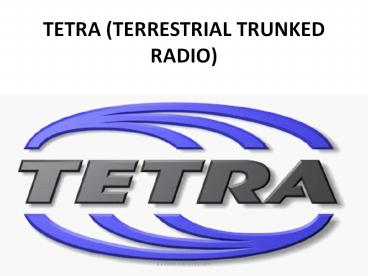TETRA (TERRESTRIAL TRUNKED RADIO) - PowerPoint PPT Presentation
1 / 21
Title:
TETRA (TERRESTRIAL TRUNKED RADIO)
Description:
WHAT IS TETRA * Advanced Digital Radio Communications System for Public Safety Services, Utilities, Transport, Local Government, Military – PowerPoint PPT presentation
Number of Views:2993
Avg rating:3.0/5.0
Title: TETRA (TERRESTRIAL TRUNKED RADIO)
1
TETRA (TERRESTRIAL TRUNKED RADIO)
2
WHAT IS TETRA
- Advanced Digital Radio Communications
System for Public Safety Services, Utilities,
Transport, Local Government, Military - Operational throughout Europe, Asia-Pacific,
Africa, South America and Middle East - Standard promoted by ETSI
- Multi-vendor supply / interoperation
3
FREQUENCY RANGE
- 1. 400 MHz
- 380 - 400 MHz for public safety systems
- 410 - 430 MHz for commercial applications
- 2. 800 MHz for commercial applications
- standard based on TDMA technology with 4
timeslot and 25 kHz band
4
TETRA is superior PMR technology
- Individual and group communications
- Direct mode communication between radios
- Packet data and fast data transfer services
- Over-the-air programming of radios
- Frequency economy
- Fast call set-up time
- Security features
5
To ensure an open multivendor market, TETRA
specifies the following essential interfaces
- Air Interface ensure the interoperability of
terminal equipment - from different manufacturers.
- Terminal Equipment Interface (TEI) facilitates
the independent - development of mobile data applications.
- Inter-System Interface (ISI) allows the
interconnection of TETRA - Networks from different manufacturers.
- Direct Mode Operation (DMO) guarantees
communication - between terminals also beyond network
coverage .
6
TECHNOLOGY OF TETRA
7
TETRA TDMA
- 41 TDMA (Time Division Multiple Access)
- 25 kHz carrier spacing
- Digital modulation, ?/4 DQPSK at 36 kbits/s
- Speech calls use one channel
- Data calls can use up to 4 channels ( Data
transfer rates up to 7.2 kbit/ s per channel)
8
Air Interface - TDMA Illustrated
9
PHASE SHIFT KEYING PROCESS
010
001
011
45
100
000
101
111
110
10
WIRELESS CHANNEL AT TRANSMITTER END
PROPAGATION CHANNEL
11
WIRELESS CHANNEL AT RECIEVER END
PROPAGATION CHANNEL
12
7 CELLULAR CONCEPT4 ARFCN IN ONE CELL4728
ARFCN
13
HANDOVER PROCESS
14
TETRA Traffic case - simplex calls
- Simplex Calls
- Mobile is either transmitting or receiving
- Requires operation of PTT switch (Push To Talk)
- Talk time is usually limited, typically 1 minute
maximum - Group calls are always
- simplex
15
TETRA Traffic case - duplex calls
- Duplex Calls
- Mobile is transmitting and receiving (like GSM
phone call) - Does not require holding PTT to continue
transmission - Recommended for making measurements - no talk
timer - Phone calls are usually but not always duplex
16
TETRA Traffic case - Group call
- Group call
- A call between more than 2 parties
- Call is always simplex, direct set-up
- Only possible if one or more groups have been
attached
17
TETRA is the Cost - Effective Technology
Four-channel TDMA gives excellent spectrum
economy - 4 channels in one 25 kHz carrier
Trunking technology supports controlled use of
shared networks
TDMA makes cost-effective Base Stations
18
TETRA INFORMATION
Exrtremly urgent
INFORMATION IMPORTANCE
Highly important
routine
TIME CRITICALLY OF CALL SET UP
Immediate lt1s
Urgent lt10 sec
Non urgent lt1 min
19
Difference between GSM and TETRA System
GSM System TETRA System
Designed for public cellular telephony. Designed for professional mobile radio applications.
Based on Duplex point to point communication. Based on simplex, semi duplex,fill duplex also point to point multi point to point communication.
Not suitable for emergency services (Call set up time a few seconds). Suitable for emergency services due to very fast call set up time (300 ms)
Do not maintain privacy and mutual security. Maintain privacy and mutual security.
Direct Mode Operation(DMO) is not possible. Direct Mode Operation(DMO) is possible, which supports voice and data transmission without a Base Station between Radio Terminals.
20
WORLD USAGE
21
Thank you































